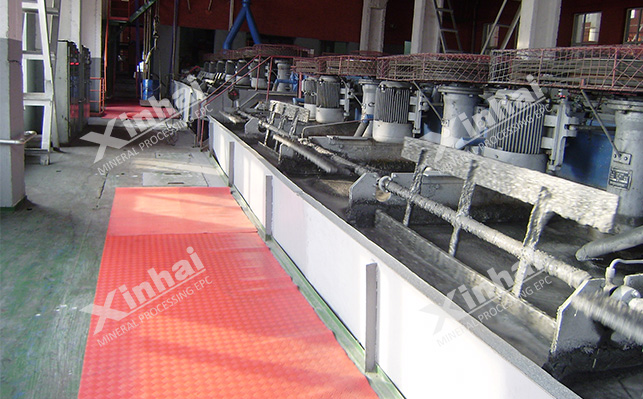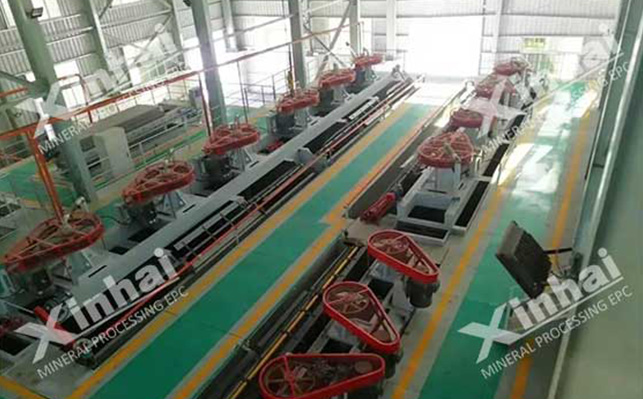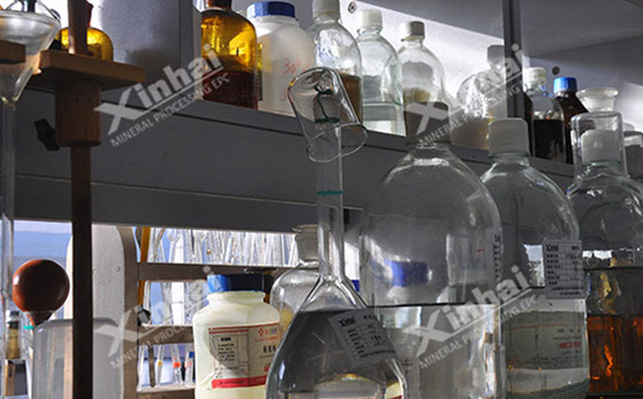
15311826613
Click to add WeChatBarete is often associated with salt minerals (such as fluorite, calcite, quartz, etc.) and metal sulfide ores (such as chalcopyrite, galena, etc.), which is the main reason for its low grade. In addition, this type of barite ore has fine interpenetration and complex components, making it difficult to beneficiate. Flotation is a commonly used barite beneficiation method, which can well adapt to the beneficiation of barite with various complex interpenetration types.
When flotating barite, the use of reagents will directly affect the separation effect, so the choice of reagents plays an important role in the flotation of barite. The following will introduce you to the barite flotation method and barite flotation reagents.

The flotation separation method of quartz-calcite barite is mainly divided into direct flotation and flotation-gravity combined process. Direct flotation is to suppress quartz and calcite first, then add anion collector to the pulp, and obtain barite concentrate after roughing and multiple flotation. The flotation-gravity combined process is to add sodium silicate and collector to the pulp first, and flotation can remove quartz. There is a density difference between gangue minerals such as calcite and barite, and barite concentrate can be obtained after gravity separation.
When separating and flotating this type of barite ore, the gangue minerals of quartz are generally suppressed first, and mixed flotation is performed to obtain a mixed concentrate of barite-fluorite, and then the barite and fluorite are separated. According to the order of flotation of barite and fluorite, it can be divided into: suppressing barite flotation fluorite and suppressing fluorite flotation barite.

(1) Suppressing barite flotation fluorite: The mixed concentrate of barite and fluorite obtained by flotation is first suppressed by barite, and fluorite is floated out. This process can simultaneously recover high-grade barite concentrate and fluorite concentrate, and is widely used in ore dressing plants.
(2) Suppressing fluorite flotation barite: The mixed concentrate of barite-fluorite flotation first suppresses fluorite ore to float out barite concentrate, and then fatty acid collectors and sodium silicate need to be added to the tailings. Fluorite concentrate can be obtained through multiple selection. This process is simple and easy to operate, and qualified barite concentrate can be obtained.
According to the adsorption form of the reagent on the mineral surface, barite flotation collectors can be divided into chemically adsorbed anionic collectors, physically adsorbed cationic collectors, and amphoteric collectors between the two.
Anionic collectors are widely used, mainly introducing fatty acids and alkyl sulfate collectors.

(1) Fatty acid collectors: Collectors widely used in barite flotation include oleic acid, sodium oleate, cyclohexane acid, oxidized paraffin soap, etc. Among them, oleic acid and sodium oleate are more commonly used, with strong collection ability and low dosage.
(2) Alkyl sulfates: This type of collector mainly includes sodium dodecyl sulfate and sodium hexadecyl sulfate, which have good selective collection ability and foaming properties, are non-toxic and easily soluble in water.
Under certain pH conditions, cationic collectors (mainly amine collectors) can effectively separate barite from gangue minerals such as fluorite, quartz, and calcite.
Aminoalkylphosphonic acid is an amphoteric barite collector, which has better collection ability than oleic acid and better selectivity. The molecular structure of this type of collector determines that it can be used in a wider pH range.
In actual production, the ore dressing plant will use a combination of agents to improve the collection ability and selectivity of the agent for minerals according to the synergistic effect of the drugs, which will obtain better flotation effect than a single collector.
Since the floatability of barite and the associated gangue minerals is similar, it is difficult to separate these minerals by flotation, so increasing their floatability difference is the key to the flotation separation of barite. According to the order of flotation of barite, the inhibitors can be divided into barite inhibitors and fluorite inhibitors.

Mainly include polymerized carbohydrates such as starch and dextrin, inorganic salts such as sodium silicate, sodium carbonate, sulfate, and combined inhibitors formed by their mixed use.
Commonly used fluorite inhibitors include sodium silicate, NaSiF6, citric acid, lignin, etc.
The above are the barite flotation methods and flotation agents with more complex components. There are various flotation methods and flotation reagents for barite. The selection of specific flotation schemes and reagents should be based on the characteristics of the ore itself and production requirements.